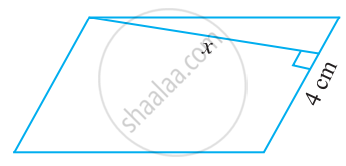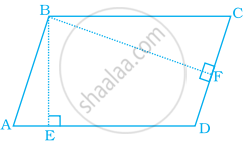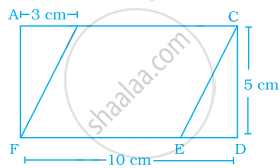Advertisements
Advertisements
प्रश्न
Find the missing value:
| Base | Height | Area of parallelogram |
| 15.6 cm | ______ | 16.38 cm2 |
उत्तर
| Base | Height | Area of parallelogram |
| 15.6 cm | 1.05 | 16.38 cm2 |
Explanation:
b = 15.6 cm
h = ?
Area = 16.38 cm2
15.6 × h = 16.38
h = `16.38/15.6`
h = 1.05 cm
Therefore, the height of such parallelogram is 1.05 cm.
APPEARS IN
संबंधित प्रश्न
PQRS is a parallelogram (see the given figure). QM is the height from Q to SR and QN is the height from Q to PS. If SR = 12 cm and QM = 7.6 cm. Find:
- the area of the parallelogram PQRS
- QN, if PS = 8 cm

A parallelogram has sides of 15 cm and 12 cm; if the distance between the 15 cm sides is 6 cm; find the distance between 12 cm sides.
Find the height ‘x’ if the area of the parallelogram is 24 cm2 and the base is 4 cm.

Suresh on a parallelogram-shaped trophy in a state level chess tournament. He knows that the area of the trophy is 735 sq.cm and its base is 21 cm. What is the height of that trophy?
In a parallelogram the base is three times its height. If the height is 8 cm then the area is
A square and a parallelogram have the same area. If the side of the square is 48 m and the height of the parallelogram is 18 m. Find the length of the base of the parallelogram
The height of the parallelogram is one-fourth of its base. If the area of the parallelogram is 676 sq.cm, find the height and the base
Area of parallelogram ABCD (see the figure) is not equal to ______.

In the given figure, area of parallelogram BCEF is ________ cm2 where ACDF is a rectangle.

ABCD is a parallelogram in which AE is perpendicular to CD as shown in the given figure. Also, AC = 5 cm, DE = 4 cm and area of ΔAED = 6 cm2. Find the perimeter and area of parallelogram ABCD.
